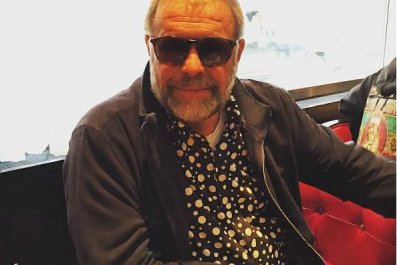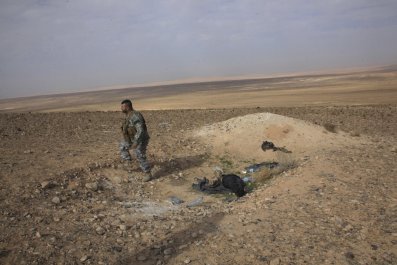Driving is one of the dreaded chores of the modern American experience. Few do it with pleasure or for pleasure. It is often expensive and sometimes dangerous. The most common rejoinder, to one who fears airline flight, is that a Toyota is far more lethal than a Boeing. And far less awesome. Soon enough, Google's integrated circuits will navigate I-95 more smoothly than you or I ever could. There will then come a time, and come soon, when a teenager accustomed only to the gentle purr of an iAuto will listen to "Born to Run" and feel no goose bumps from Bruce Springsteen's growling evocation of highways "jammed with broken heroes on a last-chance power drive," for the only highways known to this coddled and hapless youth will be the sleek, "smart" roads of the pixelated age: Facebook Freeway, Apple Turnpike, Cloud Storage Solutions Highway. He will coast along in perfect safety, perfectly bored.
"I preferred reading the American landscape as we went along," says Sal Paradise, the narrator of Jack Kerouac's On the Road. He has a French novel, stolen in Hollywood, but as his bus rolls east from California, he is transfixed by the view. "Every bump, rise, and stretch in it mystified my longing. In inky night we crossed New Mexico; at gray dawn it was Dalhart, Texas; in the bleak Sunday afternoon we rode through one Oklahoma flat-town after another; at nightfall it was Kansas. The bus roared on...."
On the Road was published in 1957, at about the height of America's postwar majesty, when you could wax Whitmanesque about the whole vast place without coming off as a master ironist. But unlike old Walt, you didn't laze about observing spears of summer grass; you hopped into a Cadillac Eldorado, roaring West at a not-very-green 9 miles per gallon, Frankie Avalon crooning into the wind. To Sal and his benny-addled bunch, Route 6 and its fellow byways are the American version of the Khyber Pass, the Camino de Santiago, the Orient Express. Whatever way the compass points, the true direction of the journey is always inward, ever deeper into the infinite soul of the land.
The year before Kerouac published the novel that made him famous, President Dwight Eisenhower signed the Federal Aid Highway Act, which created the interstate system of roads, now 46,876 miles in length, about twice the circumference of the Earth. The interstate system replaced an older network of two-lane blacktops called the U.S. Numbered Highway System, inaugurated in 1926. Today, these are the lesser roads known as "U.S. Routes," designated with a black-and-white shield. The most famous of these old roads are probably the Lincoln Highway, which was the first to connect the coasts, and Route 66, from Chicago to Santa Monica, the "Mother Road" that signaled the ascendancy of the Mountain West and the Pacific Coast in the American imagination. There are others too, nearly as legendary: the Pacific Coast Highway, which traces the craggy convolutions of the California coastline; the Blue Ridge Parkway, plunging boldly into the secret heart of Appalachia; the Historic Columbia River Parkway, blazing through the lush sublimity of Oregon.
And then there is Route 50, a black ribbon that stretches from Ocean City, Maryland, to Sacramento. "For the unhurried, this little-known highway is the best national road across the middle of the United States," wrote William Least Heat-Moon in Blue Highways, his classic 1982 account of driving the nation's back roads in search of the nation's heart. Fifteen years later, Time magazine called this same strip of pavement "The Backbone of America" in a cover story that was part travelogue, part sociopolitical pulse-taking. It is a long backbone, 3,007 miles in length, its vertebrae etched with names like Loogootee, Pruntytown, Poncha Springs and Majors Place.
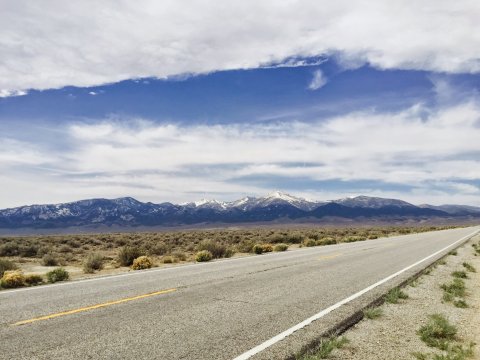
The most famous segment of Route 50 is largely useless, running through Nevada about 100 or so miles south of I-80, which is what sane people use today to travel the state (sane people of means simply fly). And yet this 287-mile stretch between Fernley, near the border with California, and Ely, near the border with Utah, has attained legendary status as the "Loneliest Road in America." The designation was made by Life magazine in 1986 and has stuck, in good part because Nevada tourism authorities recognized what the acolytes of ruin porn have long known about the strange magic desolation works on the human spirit. There are, today, "Loneliest Road" signs along the road, and some stores in the sparse towns along Route 50 display "I survived Route 50" signs in windows covered with geologic layers of grime.
You can even get a slick "survival guide" to the road, which the governor of Nevada will supposedly sign if enough businesses along the way stamp its passport-like pages. This is a transparently cheesy gimmick, but given some of the spiky characters who populate towns like Eureka and Austin, it is not without its attendant dangers.
Nor is the road exactly bumper-to-bumper with tourists, despite an impressive marketing effort by the aforementioned Nevada officials. I drove it alone, from Delta, on the Utah side of the border, to Sacramento, where Route 50 terminates in the bleak outer edges of the city. I suspect that most of those who choose to drive the "Loneliest Road" want true loneliness, which friends and lovers and little children and chatty cousins would surely ruin. So would the sound of a radio; though I spent some of the drive listening to a Jon Krakauer audiobook, I often drove along in silence, convinced that this is how they would want me to do it, they being both the Nevada tourism savants and Sal Paradise, whispering in my ear about "the magic land at the end of the road."
'We Warn All Motorists...'
It was about a week after driving Route 50 from Utah to California that I actually managed to find the famous Life magazine article that made this stretch of blacktop world-infamous. A sallow, straw-haired librarian at the Sacramento Public Library set down a box of issues from the mid-'80s, and I flipped lazily through them, past advertisements for healthful menthol cigarettes and articles about the Soviets' incipient plans for nuclear war.
The "Loneliest Road" appeared in the July 1986 issue of Life, which shows the Statue of Liberty on its cover. Given how many times the "Loneliest Road" moniker has been repeated in popular culture, and how often it is cited on Internet travel guides, as if it were some kind of official designation, I figured its origin was something expansive and brutal, a missive from a latter-day James Agee or Dorothea Lange.
No such luck. There was only a single photograph. A car recedes into the distance, while in the foreground a rancher crosses the road on a horse. Both car and man-horse duo are moving with their own purpose, independent of each other. There is no hurry, as if the photograph were capturing timelessness itself.

Below the photograph is a caption that says, "The Loneliest Road." I had found the origins of the river, the secret spring of legend. There followed, beneath the caption, a single paragraph:
"It's totally empty," says an AAA counselor. "There are no points of interest. We don't recommend it." The 287 mile-stretch of U.S. 50, running from Ely to Fernley, Nev., passes nine towns, two abandoned mining camps, a few gas pumps and an occasional coyote. "We warn all motorists not to drive there," says the AAA rep, "unless they're confident of their survival skills."
So this was it. I had wondered, when first reading about Route 50, why this one deeply concerned AAA official was always cited: Had Life spoken to no one else? Had there not been a single booster for this maligned highway?
Now I saw that there had been no one else, only this AAA "counselor." He was the only guest at this desert party. And what had become of him, anyway? Did he know that his warning had been responsible for a boomlet of Nevada tourism? That he had made popular the very road he warned people away from? That what he said seriously has been taken ironically, that his words were the ones that spawned countless car journeys, including my own?
A few have even taken to complaining about how popular Route 50 has become, like some forlorn section of Detroit suddenly colonized by hipster farmers. "Making my third Highway 50 traverse," wrote a reporter for the San Francisco Chronicle in 2004, "I realized the secret is out."

Well, a decade later, the secret hasn't made it very far. You don't have to be Lawrence of Arabia to cross Nevada in a car, but the journey does require a very specific skill set: sitting for a very long time, knowing where the next gas station is; knowing how to find NPR amid the desert's FM fuzz; and most important of all, knowing how to be alone.
After my first day on the road, I texted some details of the trip to a colleague back in New York who had done the same journey years before. He wrote back, "It's strange right? A lot of time way inside your head." Way inside being the operative phrase there. Way, way inside.
Hello? God?
The land between the Wasatch Mountains, which cradle Salt Lake City, and the Sierra Nevada, which shields California from the rest of the country, is called the Great Basin. Its 113,144 square miles contain much of the American West, a vast "sagebrush ocean," in the words of Utah naturalist Stephen Trimble. The water that comes into the Great Basin does not flow into rivers. Instead, it simply evaporates or seeps into the salt beds. That makes it one of the largest endorheic watersheds in our little swath of the globe, a huge, rusty tub under a blazing, uncovered lamp.
Nevada is located in a part of the Great Basin called the Basin and Range Province, one enormous geological phenomenon within another. Imagine an old man wrinkling his forehead and you have the topography of Nevada, north-south mountain ridges with valleys in between. The 19th century archaeologist C.E. Dutton described the mountains of the Basin and Range as "an army of caterpillars crawling northward out of Mexico." To drive across Nevada is to squish the caterpillars with the tires of your car, one after another.
You cross more than a dozen mountain ranges as you traverse the state, climbing up into the red rock heights, then dipping down into the patchy desert of the valley floor. This had been the route of the Pony Express, and vestiges of that Snapchat, alpha version, can still be seen along the road, crumbling piles of rock conquered by the relentless creep of sand and grass. Later, Route 50 across Nevada became coterminous with the Lincoln Highway. Crossing the desert in a Model T Ford would have required survival skills, not to mention quite a bit of time, and given the lack of radio, a prolonged comfort with your own neurochemistry that Spotify wasn't around to alleviate.
Once in a while, curiosity tugged at the steering wheel. Outside the town of Austin, I pulled off the road to search for the Spencer Hot Springs. It had been a day of too much beef jerky, too many energy drinks and too much silence. To bathe in nature's lukewarm and restorative waters would be a perfectly salvific conclusion to a day of claustrophobic motion. And the proprietor of the Cozy Mountain Motel had made the springs seem only a short distance from the main road.
This was not the case. Following the scant directions printed on a roadside sign, I turned on a gravel road, then another gravel road, until suddenly I was on no road at all, surrounded on all sides by sagebrush. I saw no markings or signs, only the dust that rose from my wheels in a swelling, occluding storm. I consulted my phone, which returned only the dreaded "no service" message. Deep breath. The dust around my car settled, and I saw only the ancient desert, and beyond the desert the hills, and somewhere in the hills, where long ago Indians had carved petroglyphs, there was a road leading back to civilization, but unless some satellite high above shifted into auspicious position, I might become just another skeleton desiccating under the sun.

As if some cosmic force sensed my fears and wanted to confirm them, the sun blazed with particular cruelty, so bright that it hampered vision, reducing the landscape to a brown haze. Nothing moved. "A soul-shattering silence," the physicist Freeman Dyson once wrote of the Nevada desert. "You are alone with God in that silence." I was not ready to consort with my maker just yet and, revving the car again, maneuvered frantically down the gravel paths until, in the distance, I saw the glint of a truck crawling slowly into the furnace of the late Nevada afternoon.
I don't mean to be needlessly dramatic, but one should always give the desert its due. In 1999, a recent college graduate named Raffi Kodikian stabbed his friend David Coughlin to death in the tent they were sharing in the Rattlesnake Canyon of New Mexico. Kodikian would later claim that he killed his friend only to save him. He wrote in his journal, "We will not let the buzzards get us alive."
The tragedy of Coughlin's death was compounded by the fact that the two men, neither a seasoned outdoorsman, were never more than a mile from where they had parked their car. The desert, constitutionally incapable of forgiveness, punished them deeply for their inexperience. It has no reason to show any one of us more mercy.
Renewed in the Wild
Sometime in the eighth decade of the fourth century, a pious Christian named Eusebius Sophronius Hieronymus decided to head out into the Syrian desert. He believed this would make him a better servant of God: "O desert nourishing the flowers of Christ! O solitude which produces the firm rocks with which the city of the Great King is constructed," he would later write. During his sojourn in the pitiless desert, the faithful hermit purified his faith in God. Today, we know the desert wanderer as St. Jerome, one of the Four Fathers of the Catholic Church.
Not all of us go into the desert to become saints. Some of us go simply to become human, which today might mean nothing more than a couple of days without wireless service. The desert is one of the last great repositories of pure silence, which has become as commodified as a truffle in a world that constantly dings and pings and yaps for your attention. A couple of years back, a Brooklyn restaurant achieved short-lived notoriety by mandating that diners not talk at all during their meals. At around the same time, Susan Cain's Quiet: The Power of Introverts in a World That Can't Stop Talking was becoming an international best-seller.
I suppose, then, that Route 50 can be considered a meditation retreat with a speed limit—mindfulness at 100 miles an hour. That isn't the posted limit, of course, but I didn't encounter a single highway trooper in two days of driving. The only traffic-calming measures in Utah and Nevada appear to be the tumbleweeds that burst every so often across the road, threatening to lodge in some crucial component of your car's undercarriage and catch fire. Otherwise, it's just you and Nevada's endless sine curve. You can't ever quite tune out, but the nerve-fraying experience of trying to navigate five measly blocks of Broadway at rush hour is replaced by an uninterrupted calm. Sometimes, as I drove, I felt as if I were floating. I would look down at the speedometer as the needle crept with smooth confidence toward triple digits. But I wasn't being careless or reckless. I wasn't rushing. I did not need to make good time. I did not want to make good time. I was doing only what the road wanted me to do.
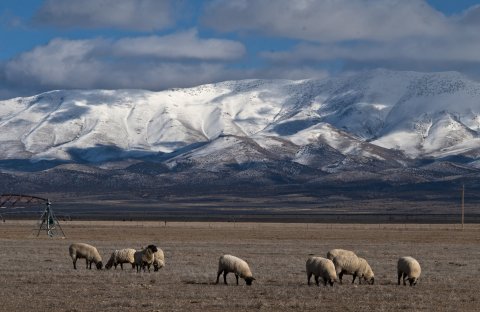
I rarely stopped during the two-day journey. Not because I had anywhere to be, but because the thwack of rubber on asphalt was a sort of symphony, and to disrupt that music would be like taking a phone call during Beethoven's Fifth. There was, moreover, something psychologically unpleasant about stopping, as I discovered when I pulled over near Sand Mountain, in Nevada, and walked across some roadside salt flats that had the appearance of a Siberian tundra, white in every direction, the supreme white that, as Herman Melville wrote, "shadows forth the heartless voids and immensities of the universe."
Stepping out of my rental after several hours of driving was like launching into space. The silence crashes over you, overwhelms you like a sudden change in atmospheric pressure. It is better to keep moving, I concluded, to ride the silence like a wave, an awesome force that is neither malevolent nor gentle. The silence of the desert has been around for millions of years. You will not disturb it much. And so I kept moving, past Sand Mountain, toward Fallon, Carson City, South Lake Tahoe, back into the restless noise of the modern world.
But even once I was in Sacramento, refreshing my iPhone news apps and making the necessary ministrations to my social media accounts, the desert stayed with me. Not as an experience harrowing or triumphant or worthy of let's-have-another-beer storytelling, but as a place I had not known but would never forget, a tattoo on my city slicker's psyche.
In 1960, the great Western writer Wallace Stegner wrote what has come to be known as the "Wilderness Letter" to a young Berkeley conservationist. Stegner argued that the preservation of wilderness is necessary because wildness is a crucial aspect of the American soul. The American, he wrote, "is a civilized man who has renewed himself in the wild."
The restorative power of nature has become a tired concept, laden with the glib promises of eco-hotels and yoga retreats: Pay us to make you pure, they all whisper from behind their reclaimed-bamboo screens. I don't think this is what Stegner had in mind. For him, the wilderness ought to remain "a lovely and terrible wilderness, such as wilderness as Christ and the prophets went out into," a desert illumed by torches, not aromatherapy candles.
'A Sinkhole for Curious Ideas'
You can thank our Jeffersonian system of states' rights for the fact that each state has its own identity, its own politics and culture. The distance between Vermont and New Hampshire is immense, despite the 275 miles of border those two tiny states share. This patchwork nation, with its variegated geography and ethnic constitution, makes it alluring to visit all 50 states in the way that, I am pretty sure, nobody ever dreams of visiting all of Sweden's 25 provinces. In my native Soviet Union, I can't recall anyone boasting of having traveled through all of the "stans." If you traveled through all of the "stans," you were probably a nuclear scientist or a spy.
As a non-native American who grew up on cowboy fiction very poorly translated into Russian ("Howdy, partner" doesn't Slavicize well), I'd willfully retained an image of the American West as a romantic repository of the nation's fundamentally un-European spirit. I had done the tourist thing in scruffy Albuquerque and yuppie Taos, New Mexico; the artisanal sausage thing in Denver and artisanal beer thing in Boulder, Colorado; and the driving really, really fast thing in Arizona. Only Nevada remained unexplored.
To reach Route 50 from Salt Lake City, you first drive south on Interstate 15, turning off shortly after passing through Provo. This is the heart of Mormon country, but it is more than that: Provo is one of the few places in the United States where Google Fiber is available, and the surrounding area has been called "the next Silicon Valley" by The New Yorker and other outlets. Between the tech scene in the south and the skiing in the north, Utah has managed, despite its reputation for piety and probity, to market itself as a cool Western state. (The Sundance Film Festival probably helps too.)
Nevada is a stranger, more malevolent beast. It is much bigger than Utah and slightly less populous, giving it some of the lowest population density in the United States. In the popular imagination, Nevada is a repository for casinos (Las Vegas) and nuclear waste (Yucca Mountain), a gamble of its own. It is home to not only the "Loneliest Road in America" but also the Extraterrestrial Highway, a stretch of Route 375 along which alien spaceship sightings are common, if not credible. Nevada is a place, then, where you may consort with your thoughts or with visitors from Jupiter. You may also consort with a lady of the evening: Nevada is the only state where prostitution is legal.
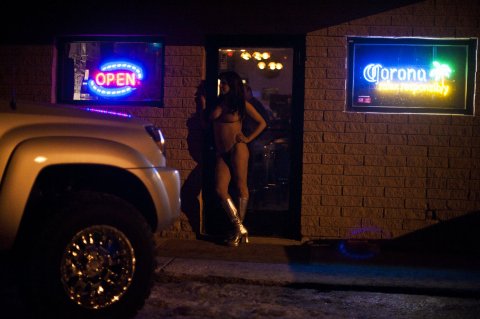
Route 50 is part of this lore but has a lore all its own. The "Loneliest Road" is an artery rich with the mythical nutrients of the American West, the one not yet ravaged by Wal-Mart and methamphetamine. No matter how fast your car is hurtling forward, you will always be traveling back in time.
This is the true Nevada, the one that has lured generations of those touched with a romantic spirit, the one that has nothing to do with blackjack or Harry Reid. Cheryll Glotfelty, in her anthology Literary Nevada, notes that the emptiness of Nevada is maybe its most attractive quality (Las Vegas and surrounding Clark County account for about 70 percent of the state's population). She cites the British writer J.B. Priestley, who wrote in 1937, "We traveled for hours and hours along narrow dirt roads through the high emptiness of Nevada. Anybody who is under the impression that the world is becoming too crowded should move into Nevada. A road there seems to lead endlessly from nothing to nothing."
Perhaps because both nature and the human mind abhor a vacuum, Nevada has become a repository for conspiracy theories, the foremost among them centered on Area 51, where some think the American government has long harbored evidence of extraterrestrial contact. Reporting for Time back in 1997 for its Route 50 issue, the novelist Walter Kirn wrote that "Nevada's Great Basin is a paranoid Holy Land, and no place better suited for the job...a sinkhole for curious ideas."
I got to hear some of those curious ideas from the Serbian owner of the International Cafe & Bar in Austin, a ramshackle building whose smoky, crepuscular interior hid a handsome 19th century bar that was like the only gorgeous woman in a room of wrinkled spinsters. The owner spoke with a strange accent, a mixture of Southern Europe and central Nevada. He had ideas about "Barack Hussein Obama" and about how drunken driving laws were a conspiracy (but of course!) between law enforcement and insurance companies. Pouring me a syrupy Serbian brandy I had not asked for, he regaled me with theories of race relations that seemed to borrow equally from Sean Hannity and Adolf Hitler. Whether he was paranoid, insane or drunk I don't know, but no amount of alcohol could make his diatribe bearable. I ended the night in the Cozy Mountain Motel, eating beef jerky and drinking beer from a plastic cup, a man alone on the "Loneliest Road," lonely and loving it.
Exalted Emptiness
The high desert is austere but never plain. Birds flit, grasses sway. Shadows flirt with red rocks, and where trucks traverse dirt roads in the distance, clouds of dust follow them, as if the Tasmanian devil of cartoon fame were giving chase. Abandoned farmhouses stand on their final wooden legs, testifying to lives that were surely hard and probably short. Cows mulch. Cars whiz by, and you momentarily feel the kinship with a fellow human being. But then the car passes, your own car shakes from the pneumatic force of the turbulence, and you are totally alone again.
To travel the "Loneliest Road" is to prove King Lear's maxim that nothing will come of nothing. For large swaths of road, the nothingness is utterly uninterrupted, giving birth only to more of itself, an emptiness so vast it is impossible not to be awed by it, the exalted emptiness of Kierkegaard and Sartre, the emptiness that may make us all better people if we stopped to ponder its philosophical implications for a moment. I have never understood the claim, routinely made by visitors to New York, that they are made to feel insignificant by the towers of Manhattan; humans built them, humans work in them, humans can pay $15 to ride up to their observation decks and look down at the surface of the Earth 1,000 feet below. If anything, the towers of Manhattan affirm humanity's powers. The desert, which existed before us and will exist after us, affirms humanity's insignificance.
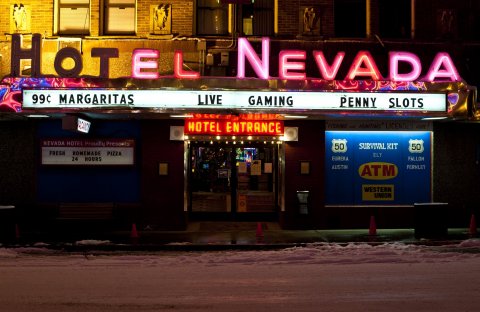
The towns along Route 50 are notable not only for their smallness but for their rarity. Some of them are merely a rest stop with a restaurant attached. Eureka advertises itself as "the Friendliest Town on the Loneliest Road in America." I never did discover whether that was true. Austin claimed, on a billboard, that there was "so much to do" within its 1.1 square-mile confines. This I can confidently say is hyperbole, though of the harmless sort (except for the racist Serb; seriously, stay away from the racist Serb). Carson City, near Lake Tahoe, is a true American dump, but you can buy the temporary companionship of a woman at the Sagebrush Ranch, a gun at the Half Cocked Armory, then gamble away what remains in your wallet at the Gold Dust West casino. Best of all, most towns along Route 50 do not peter out into strip malls and condo developments, as towns do in so much of the rest of America. They simply end, and the wild country begins again.
Outside of Austin, I climbed a dirt road to a stone tower called the Stokes Castle. It was built in the late 19th century by Anson Phelps Stokes, a patrician New Yorker who owned some mines in the area. Having once seen a similar tower during a tour of Italy, he decided to build a replica in Nevada, in hopes of turning it into a summer hermitage. But with its lack of adornments, its utter solitude, the tower does not inspire visions of Campagna. It belongs here in Lander County, a monument to nothing but human wealth and will.
Inside, at least, the tower was lavishly outfitted; there was a curtained roof deck, where Phelps may have taken his evening cocktail, entranced by the pure stillness of the hills. Or maybe he was not so entranced, maybe Bar Harbor or Newport beckoned, for the tower was used only in the summers of 1897 and '98. Surrendered to time, wind and thieves, the tower stood dying until 1956, when it was rescued, via purchase, by a concerned Stokes relative.
Today, the Stokes Castle is fenced and outfitted with historical markers, allowed to stand in arrested decay. Hardly anyone ever lived here; nobody will live here again. Overlooking the hills, the tower indeed looks like the vestige of some great medieval fortress. But there are no invading armies coming, for there is nothing here to take. There is only the rare 18-wheeler pushing ever deeper into the Nevada ranges, the lonely tourist screaming down the lonely highway, looking for something but finding only endless road ahead.




